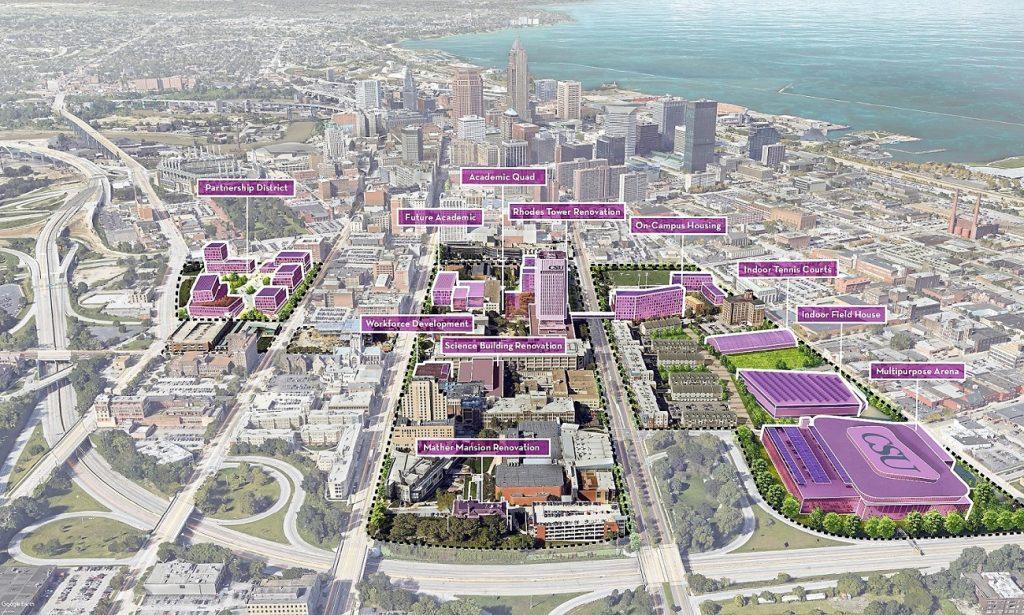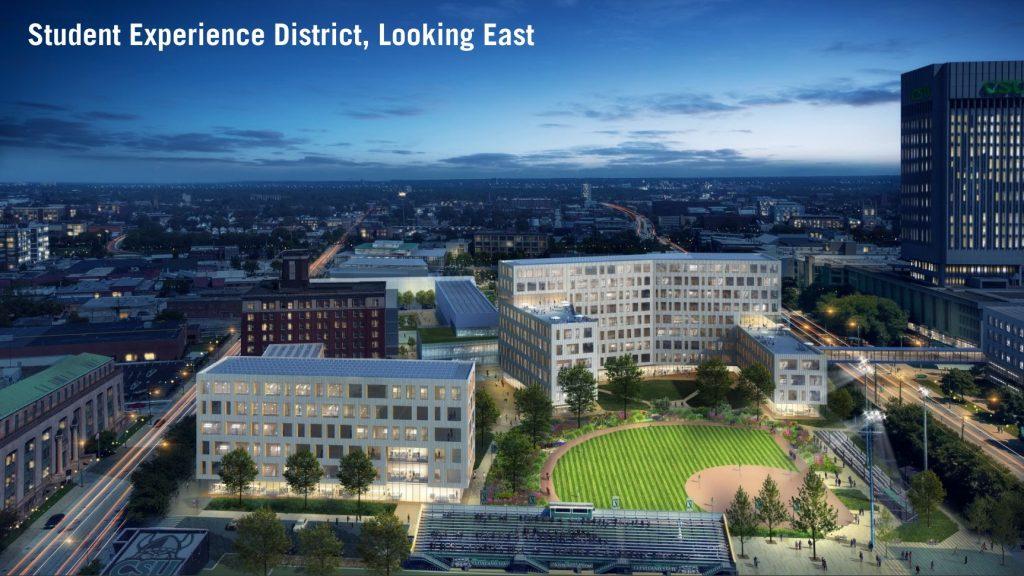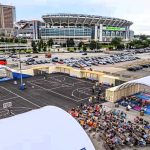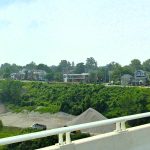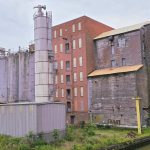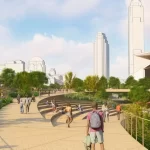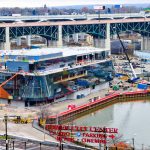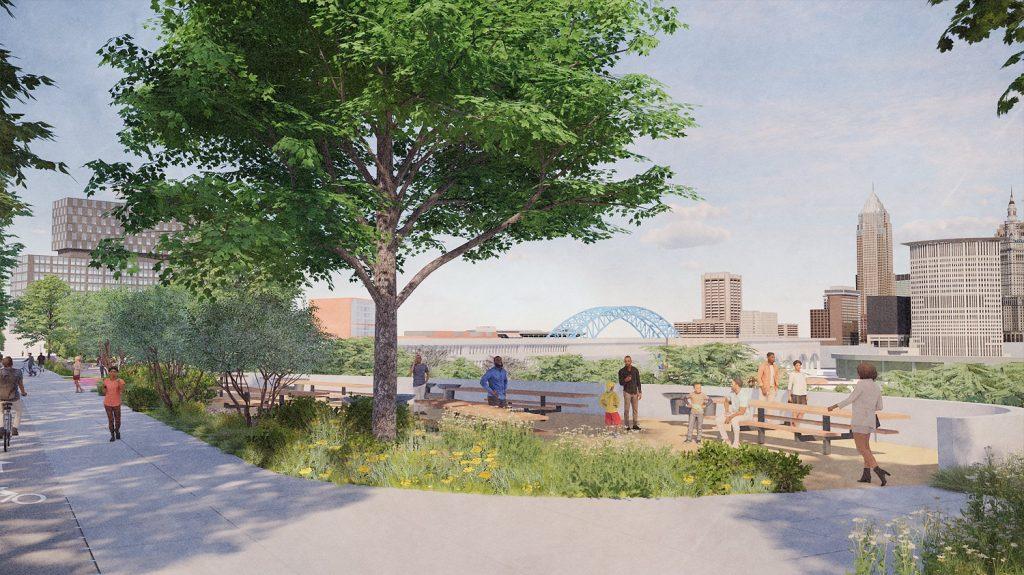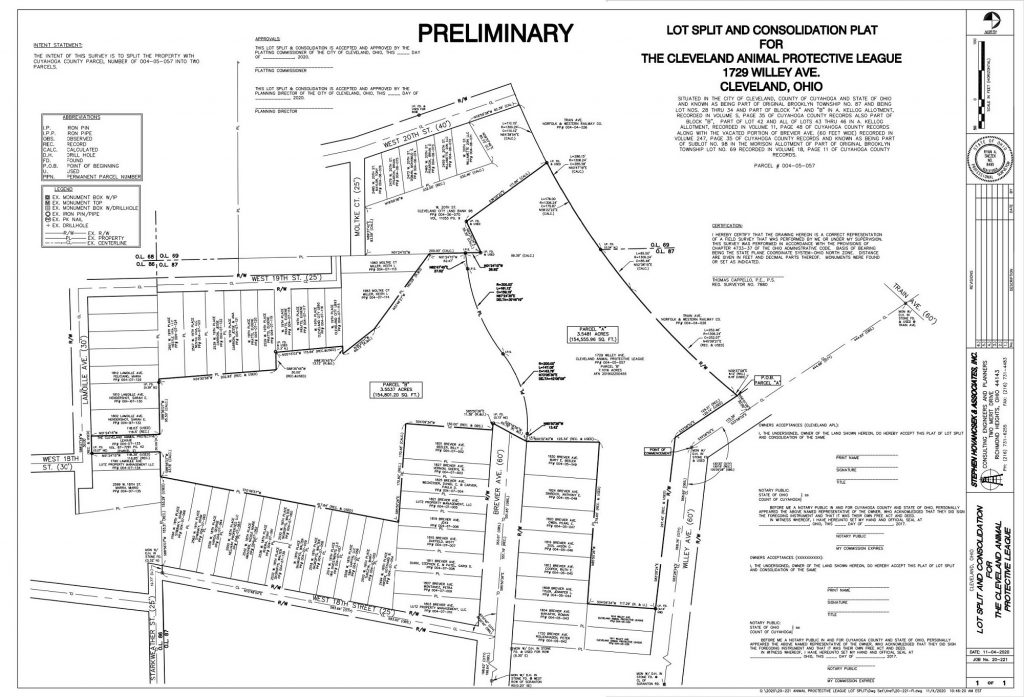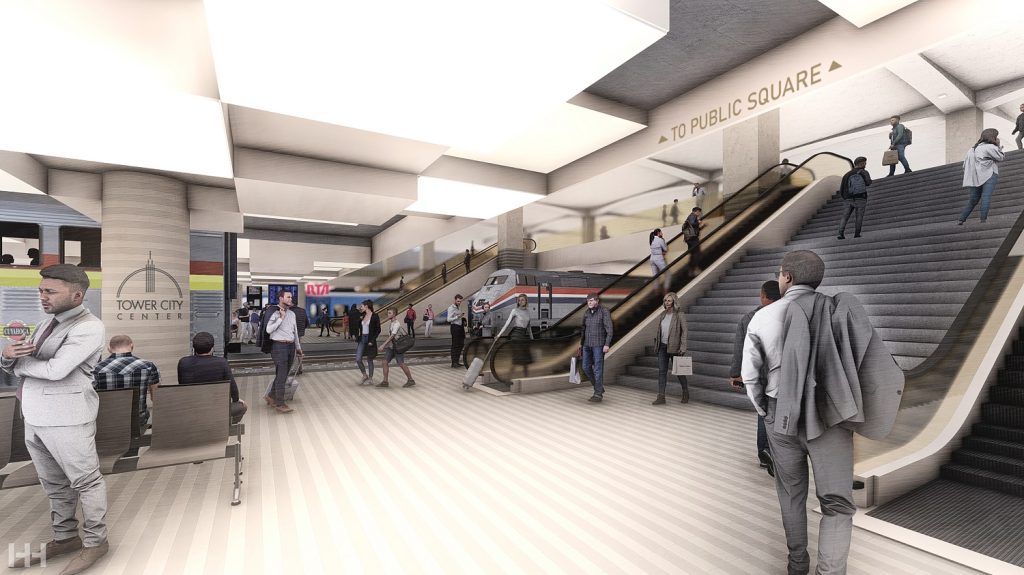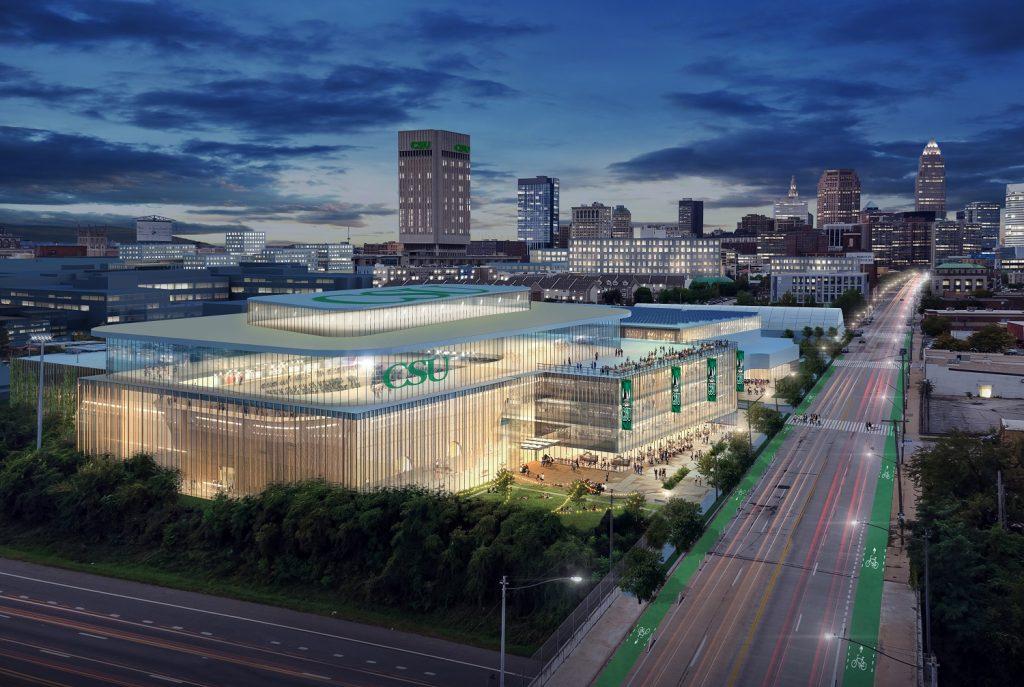
Conceptual rendering of a new 5,000- to 7,000-seat arena for Cleveland State University on Payne Avenue overlooking Interstate 90, at lower left. The new arena would host CSU basketball, concerts and other events and allow the university to demolish the 13,610-seat Wolstein Center. The 9.3-acre Wolstein Center site would be redeveloped as the Partnership District with up to 800,000 square feet of new mixed-use development (CSU/Sasaki). CLICK IMAGES TO ENLARGE THEM
Plans call for 3 new campus districts
At a regular meeting today of its board of trustees, Cleveland State University (CSU) unveiled a new campus master plan to capitalize on its location in Cleveland’s urban core and to guide the development of the university’s physical campus over the next decade. Details of that plan were shared with NEOtrans and other Northeast Ohio media in a press release and an illustrated presentation.
The estimated $650 million campus master plan was termed a proposal to the community and designed to support the university’s academic and research missions, enhance the student experience, increase and elevate on campus housing, expand partnerships and drive economic development in downtown Cleveland’s Campus District. In June 2020, NEOtrans was first to report that CSU was seeking an update of its 2014 campus master plan.
NEOtrans followed-up on the progress nine months later to report that CSU hired Boston-based Sasaki Associates to develop the plan. But progress that was slowed by internal disagreements on other CSU matters, leading to the unexpected departure of CSU President Harlan Sands earlier this year. But the need for the master plan remained, including the desire to develop more on-campus housing which is limited to only two residence halls. Demolishing the oversized, 31-year-old, 13,610-seat Bert L. and Iris S. Wolstein Center arena, 2000 Prospect Ave. and redeveloping the site was a high priority, as was building a newer, smaller arena nearer to Interstate 90 so CSU could take better advantage of its urban location.
“Our location in downtown Cleveland is one of our greatest assets,” said CSU President Laura Bloomberg. “As an urban public research university, we have a special obligation to serve the public good. For CSU that means providing an accessible, quality education for all on our campus, while serving as a catalyst for growth for our city and the region. Our master plan provides the infrastructure to support that mission.”
CSU’s master plan calls for a mixed-use, compact campus core that strengthens corridors across campus and better connects the university to the surrounding city. It lays out a strategy for new and updated communities on campus that include the Academic Core, a Student Experience District and a Partnership District.
Academic Core
Plans for the Academic Core, an area bounded by Carnegie and Euclid avenues between East 22nd and East 18th streets, call for a renovated Rhodes Tower, new student housing, a new academic building and a new campus quadrangle. Built in 1971, the 363-foot-tall Rhodes Tower is the fourth-tallest educational-purposed building in the United States, according to the Encyclopedia of Cleveland History.
Rhodes Tower, now a classroom and office building housing the CSU library, will be completely re-imagined. Plans for CSU’s signature building call for student life and social space around the library on the first four floors of the building and 13-floors of new housing for nearly 500 students.
“Bringing together living, learning, dining and recreational spaces in our iconic building is designed to activate and energize our campus core,” said David Jewell, CSU senior vice president of business affairs and chief financial officer. “Rhodes tower will be the hub of a dynamic, active, 24/7 community.”
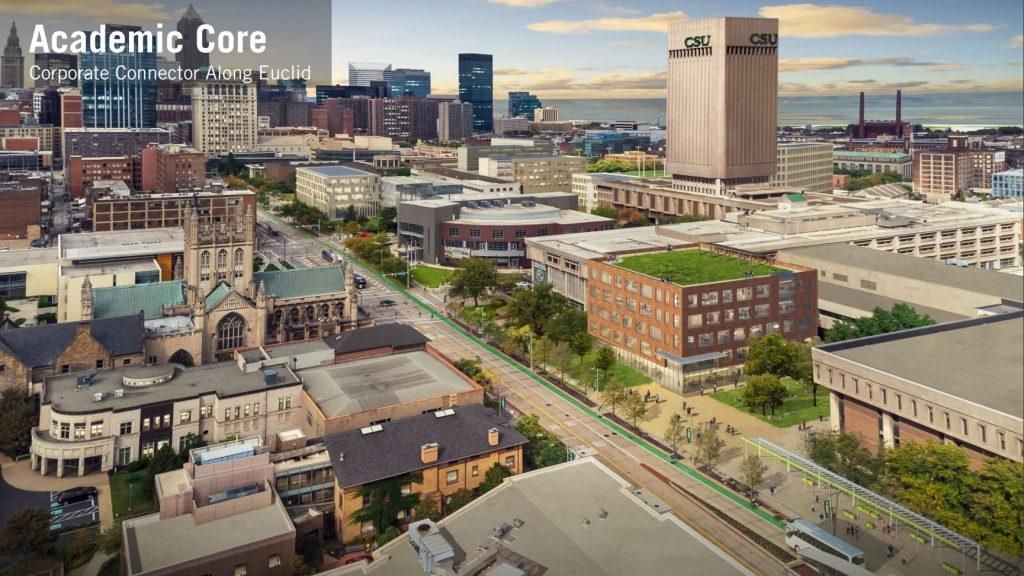
One of the first tangible results from the new campus master plan is a proposed $21 million Corporate Connector building, shown here with a green roof below Rhodes Tower. Serving as a workforce development center, the new building could see construction by the end of next year in the 2300 block of Euclid Avenue, developing a greenspace in front of the Science Research Center (CSU/Sasaki).
The master plan is designed to provide a flexible framework for campus development. That adaptability is illustrated by two new academic buildings to the west of Rhodes Tower. The buildings will house active learning classrooms, laboratories and collaborative spaces and be designed to evolve with changing teaching and learning methods. One of the buildings will include campus housing.
A campus quad will be created between a new academic building and the Music and Communication Building to the south. The new quad will connect to the existing student center plaza – dramatically expanding greenspace in the campus core. The academic core also includes plans for a Corporate Connector building to the East of Berkman Hall. The center will provide a “front door” to the University for corporate and other partners linking them to research, faculty experts, and a talented workforce made up of CSU graduates, and students.
The design also improves pedestrian access and movement through the area and includes critical intersection improvements at Chester Avenue and East 21st, Chester and East 22nd, Euclid and East 21st and Euclid and East 22nd.
Student Residential Experience
The Student Residential Experience District planned for the area north of Chester between East 18th street and I-90 will feature additional student housing, student recreation and athletics facilities.
A signature element of the new residential and entertainment neighborhood is a new proposed multi-purpose arena that would replace the university’s venerable Wolstein Arena. The 5,000- to 7,000-seat arena will be home to CSU basketball, concerts and other events. It could also house learning spaces for complementary academic programs like sport and entertainment management.
The neighborhood connects Krenzler Field and the university’s softball field on the west side of campus to the new arena and current Student Rec Center in the east. Plans for additional recreation and athletics facilities include a new indoor field house and covered tennis courts.
“We’re excited about the opportunity to better link our students and the community to CSU athletics while creating vibrant entertainment opportunities in this part of downtown,” Bloomberg said. “We want enhance the experience for our students, student athletes and fans, and draw more visitors to campus.”
Three new residence halls are planned for the center of the neighborhood providing housing for nearly 1,400 students. Adding student housing is a key part of the university’s strategic plan to increase enrollment.
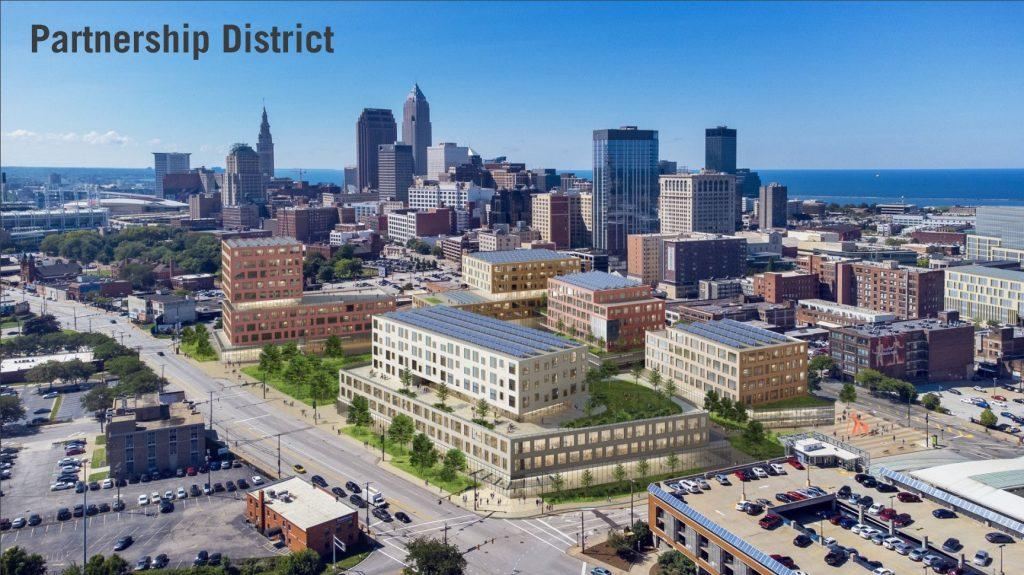
The Wolstein Center arena is proposed to be demolished and replaced with a collection of buildings described as the Partnership District but with few details as to what users would occupy them. The surrounding area is already littered with 20-plus acres of under-utilized surface parking lots and no active plans to develop them. This view looks west from above the intersection of Carnegie Avenue and East 18th Street (CSU/Sasaki).
Partnership District
The planned Partnership District would be built on the current, 9.3-acre parcel on which the Wolstein arena sets on Prospect Avenue. It could be home to nearly 800,000 square feet of mixed-use development designed to drive economic development in the area and connect partners to the university.
“This district provides an opportunity for us to work with the city, county, and our education, corporate and health care partners to develop 10 acres of prime, downtown real estate next to a major RTA hub and a parking garage,” Jewell said. “The possible collaborations and benefits to the university and the community are only limited by our imagination.”
The University stressed that there are no firm timelines for implementing its proposal. The next steps in finalizing the master plan include development of detailed budgets, designs, timelines and funding.
END

